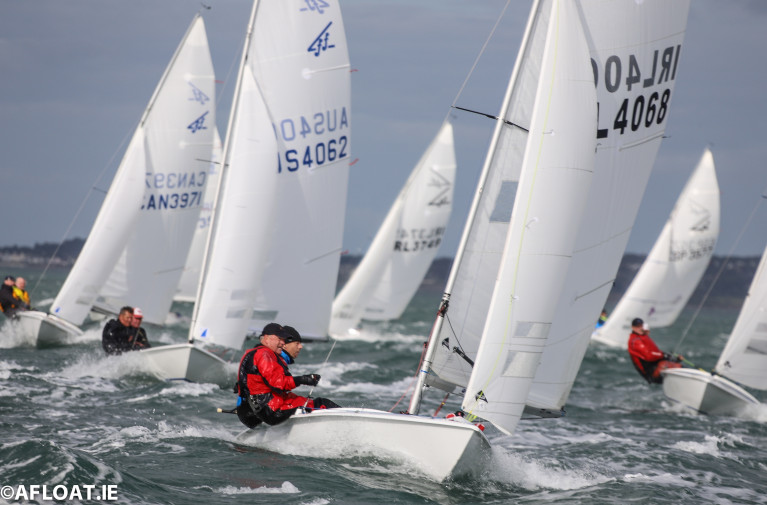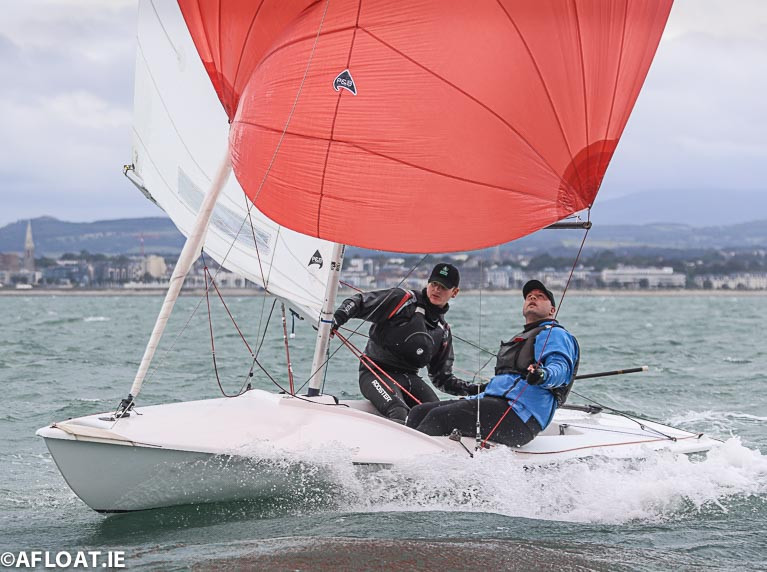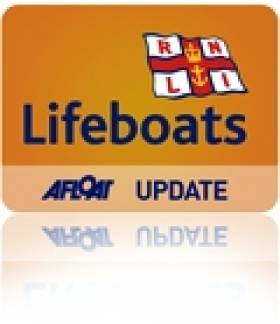Displaying items by tag: Flying ffiteen
Mulvin & Beirne's 'Ignis Caput' Wins DBSC Flying Fifteen Race
The National Yacht Club's David Mulvin and Ronan Beirne sailing the Flying 15 Ignis Caput were the winners of tonight's DBSC race from Alan Green and Chris Doorly in Frequent Flyer. Third was FFuZZy (Neil Colin & Margaret Casey).
107 boats turned out across all DBSC's 22 classes for the penultimate Thursday of the Covid-extended mid-week racing on Dublin Bay.
Conditions were gusty enough to lead to a dismasting in DBSC Cruisers Zero
 Dismasted
Dismasted
Full results below
DBSC Results for 03/09/2020
Cruiser 0 IRC: 1. Rockabill VI, 2. Prima Forte, 3. Wow
Cruiser 0 Echo: 1. Prima Forte, 2. Rockabill VI, 3. Wow
Cruiser 1 IRC: 1. White Mischief, 2. Chimaera, 3. Gringo
Cruiser 1 Echo: 1. White Mischief, 2. Gringo, 3. Chimaera
Cruiser 1 J109: 1. White Mischief, 2. Chimaera, 3. Jalapeno
31.7 One Design: 1. Prospect, 2. Levante, 3. After You Too
31.7 Echo: 1. Levante, 2. Kernach, 3. Fiddly Bits
Cruiser 2 IRC: 1=. Windjammer, 1=. Peridot, 3. Antix
Cruiser 2 Echo: 1. Peridot, 2. Antix, 3. Boojum
Cruiser 2 Sigma 33: 1. Rupert, 2. Leeuwin, 3. Boojum
Cruiser 3 IRC: 1. Dubious, 2. Starlet, 3. Maranda
Cruiser 3 Echo: 1. Maranda, 2. Saki, 3. Wynward
Cruiser 5A NS-IRC: 1. The Great Escape, 2. Edenpark
Cruiser 5A Echo: 1. The Great Escape, 2. Playtime, 3. Just Jasmin
Cruiser 5B NS-IRC: , 1. Gung-Ho, 2. Vespucci
Cruiser 5B Echo: 1. Gung-Ho, 2. Sweet Martini, 3. Vespucci
SB20: 1. Ted, 2. So Blue, 3. Carpe Diem
Sportsboat: 1. George/Riordan/Simington, 2. Jeorge 5/J Craig, 3. Jester
Dragon: 1. Phantom, 2. ZinZan
Flying 15: 1. Ignis Caput, 2. Frequent Flyer, 3. FFuZZy
Ruffian: 1. Ruffles, 2. Carmen, 3. Bandit
Shipman: 1. Invader, 2. The Den, 3. Jo Slim
B211 One Design: 1. Chinook, 2. Beeswing, 3. Small Wonder
B211 Echo: 1. Ventuno, 2. Small Wonder, 3. Plan B
Glen: 1. Glen Luce, 2. Glencree, 3. GlenDun
Dublin Bay Flying Fifteen Keelboats in Fine Fettle!
A year ago, the Irish Flying Fifteen community was gearing itself up for the Subaru World Championships in Dun Laoghaire Harbour when a 72-boat fleet contested the Championships in what was considered, post-event, to have been a very successful regatta. Of course, the fact that Race Officer Jack Roy managed to get enough races completed in conditions that embraced the full spectrum of wind strengths to give everyone a second discard helped enormously. But in addition to the wind, we had sunshine and a well-organised shore team to make sure that launching and recovery went as smoothly as possible when 72 boats are trying to get onto and off the water. Socially, the National Yacht Club and the organising committee put together a schedule that kept everyone happy.
In the build-up to the Worlds, we saw several new boats added to the fleet, Tom Murphy's 4057, "Fflagella" (late 2018), David Mulvin's 4068, "Ignis Caput II" (2019) and Bryan Willis' 4074 "Pure Gold". (2019) However, it is in the post-Worlds environment that the state of health of a class is most precarious. The Dun Laoghaire Harbour Flying Fifteen fleet has bucked the trend and seen a further injection of new boats in this Covid-19 ravaged season which only got underway in late July.
The first of these to hit the water was 4081, Phoenix, saw the return of John Lavery to the fleet with Alan Green at the pointy end. Their debut on the DBSC circuit saw them open their account with a 1, 2 on 8th August and followed it up with a 1,3 on 15th August. Since then they have added the Championship of Ireland to their haul, winning a four-race Championship in a very breezy Dunmore East with a three-day event reduced to a single day of racing. In another indication of the rude health of the Class, a significant number of boats from N Ireland contested the regatta, significant because of the combined effects of Covid-19 and the adverse implication of an unseasonal August storm that saw Friday's racing cancelled by WhatsApp at 08:00 (approx.) that morning. Saturday's racing went the same way, but the fleet went sailing on Sunday in big seas generated by the storm. Downwind was exhilarating we are told!
 Ben Mulligan and article author Cormac Bradley (left)
Ben Mulligan and article author Cormac Bradley (left)
The second of the new boats to be added to the 2020 fleet arrived later than intended due to Covid-19 and a relaxed delivery schedule. Ben Mulligan's 4081, "Enfant de Marie" hit the water on the Saturday of the Championship of Ireland, but in Dublin Bay, not Dunmore East. With the Fifteens' DBSC race cancelled, Mulligan and Cormac Bradley tested the new boat in high, blustery winds and found all systems to be working well. Their race debut in DBSC came in a fifteen-boat fleet last Saturday. The forecast was for breeze out of the north, quite strong in the early morning, but forecast to drop as the day wore on – at least to manageable strengths. Race Officer Barry O'Neill set a long course to blow away the cobwebs and was "rewarded" by the fleet misbehaving at the start, necessitating a General Recall. It would be unfair to cast dispersions as to who may have jumped the gun, but the author's sense was that it just wasn't one or two boats. It prompted Mulligan & Bradley to review which way to go up the beat, and that saw them at the opposite end of the start line to the aborted start – the committee boat. Negotiating a course around Neil Colin and Margaret Casey (4028 – Ffuzzy), they were closest to the committee boat and free to tack out to the right-hand side of the beat. Our sense was that while there was more tide out there (ebbing), there was also more breeze. Colin & Casey appeared to agree with that synopsis, and from a poor start by their standards, their decision was vindicated when they rounded the weather mark in the peloton. Mulligan/Bradley having committed from the "get-go" to that side found themselves in a healthy position as they came across on starboard to close on the mark. With the whole fleet bar those as mentioned above two going left, the debutants found themselves with a healthy gap to the chasing pack, led by Ian Matthews and Keith Poole, 3864, "The Gruffalo". Also featuring prominently was David Mulvin and Ronan Beirne (4068) and Tom Murphy with Karl (4057). Joe Coughlan and Andrew (Ash, 3913) were also well up the pecking order.
 Ian Matthews (left) and Keith Poole, 3864, "The Gruffalo"
Ian Matthews (left) and Keith Poole, 3864, "The Gruffalo"
It is testimony to the course accuracy that everyone had to gybe at least twice to make their way to the leeward mark. Mulligan/Bradley enjoyed a healthy gap to the chasing pack and maintained that distance to the second weather mark. Down the second run, Matthews & Poole closed when the leaders got themselves out of synch with the gybes, but they regained their distance when Matthews got the finish configuration wrong, going for the leeward mark, rather than rounding up to a finish line set to weather of the committee boat. They managed to save their second place, followed home by Murphy (4057), Coughlan (3913) and Colin (4028). Thus Mulligan/Bradley enjoyed a maiden win in their new boat.
The second race produced a more orderly start, Mulligan favouring the same approach as Race 1, but having to manoeuvre around Coughlan to achieve that objective. However, not all the fleet were committed to the left as had been the case in the first race and at the top mark, the leaders were Matthews & Poole. The chasing pack consisted of Mulvin, Colin, Murphy, with Mulligan back in 5th place. The run saw little change in the pecking order, but there was an element of "concertina-ing" at the leeward mark and a gap opened for Mulligan to sneak in. A quick tack on to starboard for a short hitch to the left followed by another tack saw Mulligan/Bradley virtually pointing at the weather mark, albeit from the bottom end of the beat. That short tack allowed three places to be gained over the length of the beat and saw Mulligan/Bradley chasing Matthews/Poole down the final run. They appeared to be closing at one stage, but Matthews pulled away again to maintain his lead to the finish. Mulligan/Bradley held the chasing boats off to finish second, followed by Colin, Mulvin and Murphy.
As it stands, the Saturday Series is as follows;
- David Mulvin & Ronan Beirne 26pts
- Ian Matthews & Keith Poole 35pts
- Alan Green & Chris Doorly 36pts
- Ken Dumpelton & Crew(s) 43pts
- Neil Colin & Margaret Casey 50pts
Twenty-two Flying Fifteens are on the DBSC register for Saturday, and a fleet of fifteen boats from that cohort is healthy by any measure. Outside the classes that sail to a handicap, this makes the Class the largest in Dublin Bay. We know a third new boat is destined for Dun Laoghaire, bought by an individual who is of the view that if you want regular two-handed competitive sailing, this is the only fleet that can provide it on the East Coast. We also note that the Afloat website has another Flying Fifteen (4060) advertised for sale.
Regatta-wise the fleet will sail the National Yacht Club regatta this weekend coming and two weeks later will contest the East Coast Championships at the same venue. DL Class Captain Neil Colin encourages as many boats as possible to support these two events.
Irish Flying Fifteen Championships Will Proceed Under New Guidelines at Dunmore East
After last night's announcement of new Irish Government pandemic guidelines, Chris Doorly, President Flying Fifteen Association of Ireland says the class championships will still go ahead in Dunmore East, County Waterford this weekend.
Doorly said in a statement last night the decision to proceed comes after consultation with hosts Waterford Harbour Sailing Club (WHSC) and Irish Sailing.
"Both Irish Sailing and FFAI are of the opinion that the event in Dunmore East can still go ahead", the statement says.
WHSC is taking onboard the revised guidelines both on and off the water with the priority of keeping members, competitors and the local community safe.
The WHSC clubhouse will be acting as a restaurant and not a bar with limited access to the club depending on numbers and social distancing.
The first race is scheduled for 3pm on Friday.
Meanwhile, Storm Ellen – that has already contributed to the cancellation of the Laser Nationals in Cork Harbour – may result in unsafe conditions and disruption especially over high ground, lakes and sea areas from tonight.
Cork will bear the brunt of the storm, which will produce a core of very severe and destructive winds between 9 pm and midnight tonight.
Lifeboat Rescues Flying Fifteen Crew
A rescue operation to recover a Flying fifteen keelboat and its two crew is underway on Dublin bay this evening. The 20-foot sailing boat capsized in strong north westerly winds in Scotsman's Bay. Both Dun Laoghaire's inshore and offshore lifeboats and a local RIB is at the scene.
Related Safety posts
RNLI Lifeboats in Ireland
Safety News
Rescue News from RNLI Lifeboats in Ireland
Coast Guard News from Ireland
Water Safety News from Ireland
Marine Casualty Investigation Board News
Marine Warnings

































































